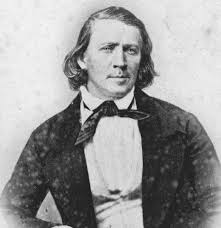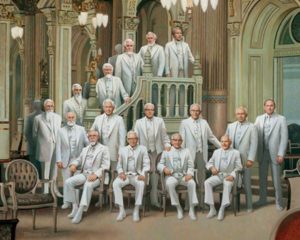We have looked at how the Mormon concept of God has moved from modalism through henotheism to the deliberately vague idea of God in modern Mormonism. In the King Follett Discourse Joseph Smith famously preached that ‘God became God.’ Here we look at how Brigham Young carried forward this idea with the Adam/God doctrine.
The Mormon Church refers today to the Adam God ‘theory’ as if it is some vague idea that is easily misunderstood and maliciously misrepresented by opponents of the Mormon Church. It was, however, a central doctrine of the church for many years, the Adam God doctrine, developing Joseph Smith’s own teaching, and taught by more than one Mormon leader.
The key to understanding this doctrine is to understand the confusing nature of Mormonism. A critic can come up with statements from Mormon leaders that clearly teach that Adam is God and a Mormon can come up with statements that contradict this view from the same, or similar sources because Mormonism contains statements that “prove” both views. To a Mormon there is no contradiction, simply a lack of understanding of the finer points of revelation.
If they cannot fully explain apparent contradictions they simply accept “on faith” that it is only an appearance of confusion and that there is an explanation somewhere. This blind faith is perhaps the most important weapon in the Latter-day Saint’s armoury, sadly not mentioned in Ephesians 6. A piece of missing scripture perhaps?

Brigham Young
The standard quote used to show that this Adam God doctrine was Mormon teaching is:
“Now hear it, O inhabitants of the earth, Jew and Gentile, Saint and sinner! When our father Adam came into the Garden of Eden, he came into it with a celestial body, and brought Eve, one of his wives, with him. He helped to make and organize this world. He is Michael, the Archangel, the ancient of days! about whom holy men have written and spoken–he is our Father and our God, and the only God with whom we have to do.”
(Brigham Young, Journal of Discourses, Vol.1, p.51)
The standard response is to accuse critics of taking Brigham Young out of context:
“President Brigham Young is quoted—in all probability the sermon was erroneously transcribed! —as having said: “Now hear it, O inhabitants of the earth, Jew and Gentile, saint and sinner! When our father Adam came into the Garden of Eden, he came into it with a celestial body, and brought Eve, one of his wives, with him. He helped to make and organize this world. He is Michael, the Archangel, the Ancient of Days, about whom holy men have written and spoken—He is our father and our God, and the only God with whom we have to do.”
If the enemies of the Church who quote this wished to be honest, they could not help seeing that President Brigham Young definitely declares that Adam is Michael, the Archangel, the Ancient of Days, which indicates definitely that Adam is not Elohim, or the God whom we worship, who is the Father of Jesus Christ.”
(Joseph Fielding Smith, Doctrines of Salvation, Vol.1, p.97)
It seems clear enough. One quote is taken out of context and words are put into Brigham Young’s mouth. But is this the case? Let’s look at Adam in Mormon theology.
“The first man,” Paul declared, “is of the earth, earthy” (1 Cor. 15:47; D&C 128:14). Adam was the first man on this earth (Moses 1:34). His mortal body was created from the “dust” of this earth or those elements that belong to this particular planet (Gen. 2:7; Moses 3:7; Alma 42:2; D&C 77:12). Upon his death, his body returned to the “ground” from whence it came (Gen. 3:19; Moses 4:25).
(Brewster, Hoyt W. Jr. Doctrine and Covenants Encyclopedia. Salt Lake City, Utah: Bookcraft, 1996.)
“I have learned by experience that there is but one God that pertains to this people, and He is the God that pertains to this earth–the first man. That first man sent his own Son to redeem the world, to redeem his brethren; his life was taken, his blood shed, that our sins might be remitted.”
(Journal of Discourses vol.4:1, Prophet Heber C Kimball, June 29, 1856)
“Who was the Saviour begotten by?…Who did beget him? His Father, and his father is our God, and the Father of our spirits, and he is the framer of the body, the God and Father of our Lord Jesus Christ. Who is he? He is Father Adam; Michael; the Ancient of Days.”
(Brigham Young, February 19, 1854, Brigham Young Collection, LDS Archives)

Mormon Prophets
So you have the first man being identified as Adam and, according to Mormon prophet Heber C Kimball, that first man sending his son to redeem the world, and Brigham Young clearly shows Adam to be the Father of the Saviour, and our God; the Adam God doctrine. He also has no difficulty identifying the Father of Jesus and our God with Michael in the same breath. Therefore Joseph Fielding Smith’s argument that Adam is Michael, a lesser being and mere “son” of God, holds no water at all.
Of course, Mormons no longer believe that Adam is God and Joseph Fielding Smith is correct in saying that modern Mormons believe Adam to be Michael, Jesus Jehovah, and Elohim God the Father. Anyone who has been through the temple endowment ceremony could tell you that. However it does not do to read what Mormons believe today into what was taught by leaders of previous generations in an attempt at portraying a consistency that clearly does not exist. This is dishonest and disguises the inconsistencies that so characterise Mormon doctrine.
The honest approach is to consider what this teaching meant to the people who first received it.
Wilford Woodruff, later to become the fourth prophet, wrote:
“He [Brigham Young] said that our God was Father Adam. He was the Father of the Saviour Jesus Christ – our God was no more or less than Adam” (Wilford Woodruff Journal, Feb.19,1854)
“President Brigham Young…said Adam was Michael the Archangel and was the Father of Jesus Christ and was our God.” (Wilford Woodruff Journal, Dec.16,1869)
So to both Brigham Young and those who heard him Adam was understood to be God the Father, the person whom modern Mormons identify as Elohim. Such inconsistency leaves the Mormons on the horns of a dilemma. If the Adam God doctrine is correct then the modern church has strayed from his teaching and is, effectively, apostate.
If it is wrong then the early church, both their prophet who taught that Adam was God and his followers who clearly understood and believed this, were following false teaching. Either way the church is bringing confusion and error where it claims to be bringing light and truth. But this is what characterises Mormonism.
Remember in the first quote, from the Encyclopaedia referring to Adam being made of the dust of this earth? Here is Brigham Young on the same subject:
“You may read and believe what you please as to what is found written in the Bible. Adam was made from the dust of an earth, but not from the dust of this earth. He was made as you and I are made, and no person was ever made upon any other principle.” (Brigham Young, April 20, 1856, Journal of Discourses, 3:319)
“You believe Adam was made of the dust of this earth. This I do not believe, though it is supposed that it is so written in the Bible. You can write that information to the States, if you please – that I have publicly declared that I do not believe that portion of the Bible…”
(Brigham Young at General Conference, October 8, 1854, Brigham Young Papers, Church Historians Office)
This brings us to a crucial part of Brigham Young’s Adam God doctrine showing that, whatever name Adam goes by, Elohim, Jehovah, or Michael, he is God in Young’s teaching.
“I tell you more, Adam is the father of our spirits. He had lived upon an earth; he did abide his creation, and did honour to his calling and priesthood and obeyed his master and Lord, and probably many of his wives did the same and they lived, and died upon an earth and then were resurrected again; to immortality and eternal life…I reckon that Father Adam was a resurrected being, with his wives and posterity…”
(Brigham Young at General Conference, October 18, 1854, Brigham Young Papers, Church Historians Office)
Here we have a perfect description of Joseph Smith’s god, who attained godhood through obedience, resurrection and eternal progression – and it is Adam. According to Mormon theology we lived with God in a pre-mortal existence and God is the father of our spirits. According to Brigham that “father of our spirits” is Adam.
But back to dust. Of which earth’s dust was Adam made?
“The Book of Mormon, the Bible, the Doctrine and Covenants and the Pearl of Great Price all declare that Adam’s body was created from the dust of the ground, that is, from the dust of this ground, this earth…We hear a lot of people talk about Adam passing through mortality and the resurrection on another earth and then coming here to live and die again…Adam had not passed through a resurrection when he was in the Garden of Eden…” (Joseph Fielding Smith (Tenth Church President), Doctrines of Salvation, vol.1, pp.90-91)
Again inconsistency is exposed as later prophets contradict earlier ones, as Mormonism tries to achieve an apparent consistency by hiding its past. In rejecting the Adam God doctrine they are not simply explaining away a few possibly badly transcribed, poorly transmitted, and ill-represented quotes.
They are jettisoning a well developed doctrine that has Adam as God, a resurrected and exalted being, bringing one of his goddess wives Eve to this earth, which he will populate with his spirit children who will be saved by Adam God’s first-born son Jesus. All who would teach such a thing in today’s church risk excommunication. All who rejected it then risked the same penalty.
Consider the following from the pages of an early Mormon publication, the Millennial Star:
“Concerning the item of doctrine alluded to by Elder Caffall and others, viz., that Adam is our Father and God, I say do not trouble yourselves…If, as Elder Caffall remarked, there are those who are waiting at the door of the Church for this objection to be removed, tell such, the Prophet and Apostle Brigham Young has declared it, and it is the word of the Lord.” (Millennial Star, Vol.16, p.534)
Clearly the objection has been removed, the word of the Lord has changed, and the door of the church is open even wider to an unsuspecting public with whom the Mormon hierarchy are being less than candid about early Mormon doctrine and contradictions across generations of Mormon leaders and followers.
Teaching Point: So whats the point of knowing this if Mormons no longer believe or teach it? We encourage Christians witnessing to cults to do two things, (1) Sow doubt in the organisation and (2) share Jesus. If you don’t have time for both share Jesus.
The Mormon Church claims to be led by living prophets who teach restored and consistent doctrine. Most Mormons think the Mormonism they experience today is the same as the Mormonism of previous generations. This is so patently untrue and I can testify to major changes in doctrine and practice within my own lifetime.
Knowing this material helps us demonstrate the inconsistencies in Mormon teaching on some of the most fundamental concepts of the faith. It helps us challenge Mormons to go back and question the claims of their own church. Such doubt creates opportunities to share the Jesus of the Bible.

